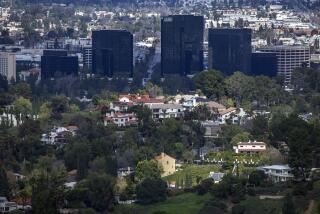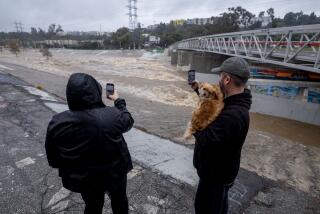Global warming in our backyard
It’s not just about the polar bears anymore. There was a time when the conversation about global warming was dominated by news about the Arctic, where its effects are the most easily visible to the lay public. The narrative involved shrinking glaciers and the ferocious white bears that live part of their lives on drifting ice floes that now are melting.
But polar bears are far away and ice is just, well, ice. So it would be a good idea for the public — and especially Southern Californians — to pay rapt attention to several reports published within the last couple of weeks that bring the reality of climate change from the polar ice caps to our backyard.
A climate change study at UCLA predicted big increases in the number of very hot days in the inland areas of Los Angeles County. Starting in about three decades, the report said, the number of days with temperatures above 95 is likely to quadruple in the San Fernando Valley, for example. The result will be more allergies among residents, bigger populations of some insect pests and worsening wildfires.
But don’t get smug if you live along the coast. The UCLA study was followed a few days later by a National Research Council report predicting that rises in the sea level will be more dramatic along the California coast than the global average, with a rise of up to a foot in 20 years and possibly more than 5 feet by the end of the century. That’s even worse than the scenario described the same week in a U.S. Geological Survey report that found sea levels already are rising more quickly along the East Coast from Massachusetts to North Carolina than they are globally. This sets the stage for catastrophic flooding, destruction of valuable buildings, costly damage to ports and even some airports, inundation of low-lying towns unless adequate sea walls are built, and erosion of coastal cliffs and beaches.
Climate skeptics typically respond to such studies by saying these predictions are just designed to scare the populace. But global warming predictions should be carrying more serious weight in the public’s mind now than they did even five years ago because of emerging patterns that closely fit earlier forecasts.
Of course, it’s impossible to say that any single event — a day of record heat, or even an especially hot summer, or a dry year or a particular wildfire — is caused solely by the warming of the planet. But one of the key predictions a decade ago foresaw increasingly serious wildfires in the Western and Southwestern United States. Last year, New Mexico experienced its worst wildfire in history, covering more than 150,000 acres. This spring, an even worse wildfire in the state blackened more than 170,000 acres. Colorado is having its worst fire season ever, and the Waldo Canyon wildfire raging there has consumed hundreds of houses. A combination of fires last year in Texas burned more than 380,000 acres within a week. And a 2006 study by Scripps Institution of Oceanography scientists implicated rising seasonal temperatures and the earlier arrival of spring conditions in worsening fire conditions in the West, starting in the late 1980s.
Other predictions made five to 10 years ago also look more like reality these days. The hottest days are now hotter. New record high temperatures in the United States have outpaced new record lows 2 to 1 over the last decade; so far this year, the ratio is more than 9 to 1. As predicted, wet areas of the country are getting wetter. In both wet and dry areas, the heaviest storms are getting heavier. And the intensity of Atlantic storms has increased in recent years.
Looking ahead, the biggest variability in climate predictions, scientists say, comes not from uncertainty about emerging patterns but from uncertainty about what humans will do — or not do — to combat global warming. The world can’t stop climate change altogether, but policies to reduce carbon emissions would have a major impact on whether sea levels rise by 3 feet toward the end of the century or more than 5.
Policies designed to mitigate the effects, after the fact, of global warming have been only slightly more effective than those designed to stop it from happening in the first place. Some coastal towns are shoring up their sea walls. In Massachusetts, developers that build in flood-prone coastal areas must meet certain requirements for the height of the lowest floor. But the nation’s fleet of heavy-duty firefighting tankers has been allowed to diminish in number to a shadow of its former strength. The times call for reacting to climate predictions with concern, but also with solid planning.
More to Read
A cure for the common opinion
Get thought-provoking perspectives with our weekly newsletter.
You may occasionally receive promotional content from the Los Angeles Times.






